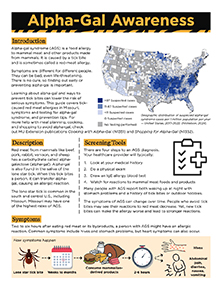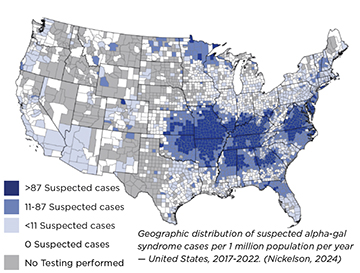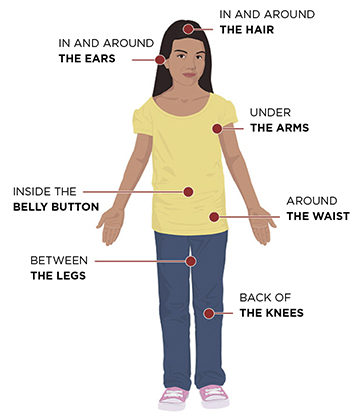Editor’s note
The following abstract describes a publication that is available for purchase or as a downloadable PDF.

Abstract
This 8.5x11" handout provides information regarding alpha-gal syndrome. Alpha-gal syndrome (AGS) is a serious, potentially life-threatening food allergy triggered by the bite of a lone star tick, which transmits a carbohydrate called alpha-gal found in the meat of mammals such as beef, pork, and venison. AGS is particularly relevant in Missouri, where tick populations are high and incidence rates may be elevated. Symptoms typically appear two to six hours after eating red meat and can range from hives and gastrointestinal distress to severe anaphylaxis. Diagnosis involves a combination of medical history, physical examination, allergy testing, and symptom tracking. Since there is no cure, prevention is key—especially avoiding further tick bites, which can worsen the condition. This guide provides vital information on symptoms, testing, and practical prevention strategies, along with resources to support individuals in managing AGS through safe food choices and tick-avoidance behaviors.
Topics
- Introduction
- Description
- Screening Tools
- Symptoms
- Reaction
- Prevention
Pages
- 2

Introduction
Alpha-gal syndrome (AGS) is a food allergy to mammal meat and other products made from mammals. It is caused by a tick bite and is sometimes called a red-meat allergy.
Symptoms are different for different people. They can be bad, even life-threatening. There is no cure, so finding out early or preventing alpha-gal is important.
Learning about alpha-gal and ways to prevent tick bites can lower the risk of serious symptoms. This guide covers tick-caused red meat allergies in Missouri, symptoms and testing for alpha-gal syndrome, and prevention tips. For more help with meal planning, cooking, and shopping to avoid alpha-gal, check out MU Extension publications Cooking with Alpha-Gal (N1351) and Shopping for Alpha-Gal (N1352).
Description
Red meat from mammals like beef, pork, rabbit, venison, and sheep has a carbohydrate called alpha-galactose (alpha-gal). Alpha-gal is also found in the saliva of the lone star tick. When this tick bites a person, it can transfer alpha-gal, causing an allergic reaction.
The lone star tick is common in the south and central U.S., including Missouri. Missouri may have one of the highest rates of AGS.
Screening Tools

There are four steps to an AGS diagnosis. Your healthcare provider will typically:
- Look at your medical history
- Do a physical exam
- Draw an IgE allergy blood test
- Watch for reactions to mammal meat foods and products
Many people with AGS report both waking up at night with stomach problems and a history of tick bites or outdoor hobbies.
The symptoms of AGS can change over time. People who avoid tick bites may see their reactions to red meat decrease. Yet, new tick bites can make the allergy worse and lead to stronger reactions.
Symptoms

Two to six hours after eating red meat or its byproducts, a person with AGS might have an allergic reaction. Common symptoms include hives and stomach problems, but heart symptoms can also occur.
Reaction
Symptoms of alpha gal syndrome reaction
- Hives or itchy rash
- Nausea or vomiting
- Heartburn or indigestion
- Diarrhea
- Drop in blood pressure
- Cough, shortness of breath, or difficulty breathing
- Swelling of the lips, throat, tongue, or eye lids
- Dizziness or faintness
- Severe stomach pain
Prevention

Stopping tick bites is key to getting AGS under control. People with AGS should avoid being bitten again. Repeated bites can make the allergy worse.
Ticks can bite at any time of year, but most bites happen from April to September. To avoid ticks:
- Stay away from grassy, brushy, and wooded areas whenever possible.
- Walk in the center of trails while hiking.
- Wear light-colored clothing so you can spot ticks more easily.
- Tuck your pant legs into your socks or tape them.
- Use EPA-approved insect repellents on exposed skin, such as those with DEET or picaridin.
- Treat clothing and gear with products having 0.5% permethrin or buy pre-treated items.
After being outside:
- Check your clothes, gear, and pets for ticks.
- Take a shower and change clothes as soon as you can.
- Remove any attached ticks right away.
- Dry your clothes on high heat for 10 minutes to kill any ticks that might still be on them.

More resources and agencies
- Center for Disease Control and Prevention
- Missouri Department of Conservation
- Missouri Department of Health and Senior Services
Sources
- McGill S., Hashash, J. G., & Platts-Mills, T. A. (2023). AGA clinical practice update on alpha-gal syndrome for the GI clinician: Commentary. Journal of Clinical Gastroenterology and Hepatology. 2. 1891-896. https://doiorg/10.1016/j.cgh.2022.12.035
- Missouri Department of Health and Senior Services (2023). Missouri tickborne disease story map. Retrieved from https://storymaps.arcgis.com/stories/d46ce3a154bf4d97bc9ba3933cd2a325
- Nickelson, P. F. (2024). Alpha-gal syndrome: Important information for Missouri healthcare and public health professionals. Missouri Department of Health and Senior Services Health Advisory. https://health.mo.gov/emergencies/ert/alertsadvisories/pdf/advisory051424.pdf